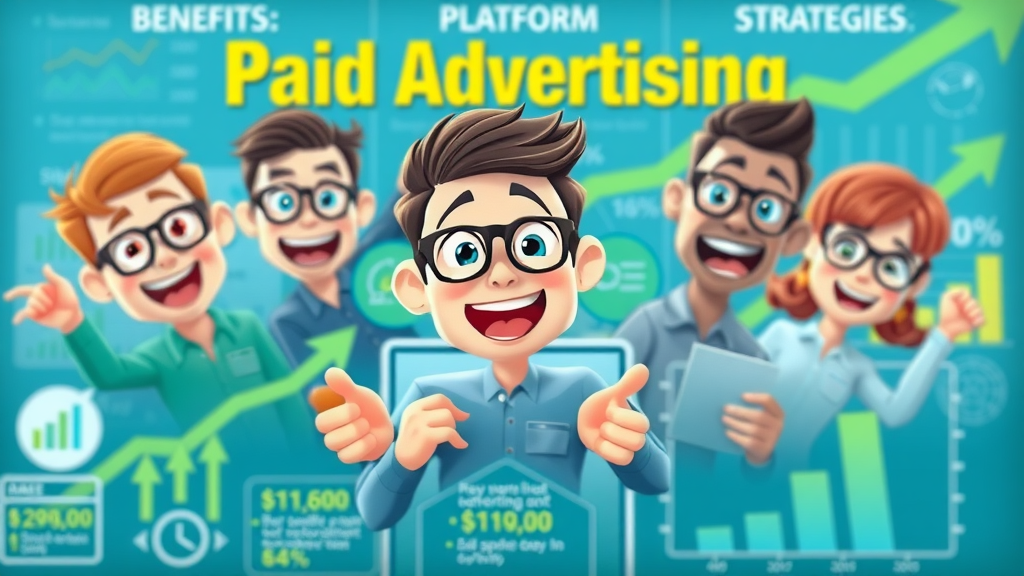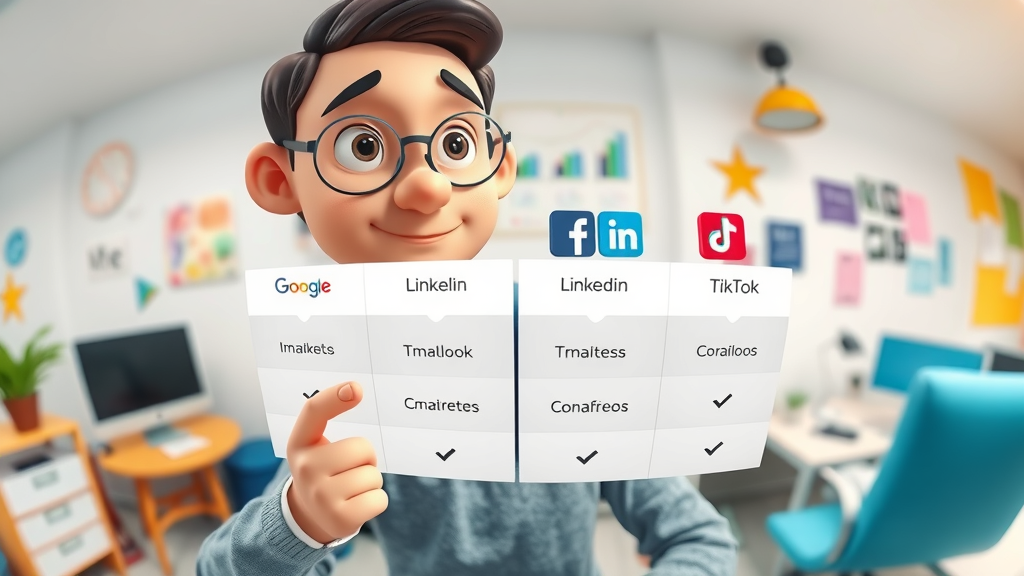Did you know? Modern businesses make, on average, $2 in revenue for every $1 they spend on paid advertising. If you want to supercharge your marketing strategy and leave competitors in the dust, tapping into paid advertising is your ticket to consistent growth and measurable results. In this comprehensive guide, you'll uncover why paid advertising is the cornerstone of digital success—and how you can use it to boost your sales starting today.

Startling Facts: Why Paid Advertising is Essential for Modern Businesses
Today’s digital landscape is crowded, competitive, and evolving at a breakneck pace. For brands eager to stand out, paid advertising is no longer optional—it’s a necessity. Research shows that businesses generate an average of $2 in revenue for every $1 spent on paid advertising (Google Economic Impact Report). That means paid marketing nearly doubles your investment, directly fueling sales and company growth. Beyond direct returns, paid ads allow precise targeting, drive brand awareness faster than organic tactics, and provide immediate data for optimizing your strategy. For organizations willing to invest in smart, data-driven marketing, paid ads are the most reliable way to increase visibility and capture valuable leads in record time.
"Businesses make an average of $2 in revenue for every $1 they spend on paid advertising." — Google Economic Impact Report
What makes paid advertising so effective for modern businesses isn’t just the increased reach, but its ability to precisely engage a specific target audience. With sophisticated tracking, advanced audience filters, and endless creative options, paid advertising delivers measurable, scalable results regardless of business size or industry. In a world where organic reach is shrinking, a strong paid ad campaign can mean the difference between stagnation and explosive growth.
As you explore the different types of paid advertising, it's important to understand how display ads can be a powerful tool for brand awareness and engagement. If you're looking to master the nuances of paid display advertising and drive more sales, check out these actionable strategies in this in-depth guide to mastering paid display advertising.
What You’ll Learn in This Guide to Paid Advertising
- Key definitions and benefits of paid advertising
- Types of paid ad campaigns and where they excel
- How to select the right advertising platform
- Step-by-step processes to launch, manage, and optimize paid ads
- Expert strategies for maximizing returns
- Common pitfalls and how to avoid them

Paid Advertising Explained: The Fundamentals
What Is Paid Advertising?
Paid advertising refers to buying targeted placements of your ads on digital platforms like Google, Facebook, Instagram, and YouTube, as well as across websites participating in display networks. Unlike organic marketing (which relies on search engine optimization and unpaid reach), paid ad campaigns guarantee visibility—to the exact users you want to reach—by leveraging advanced audience targeting and bidding systems. Whether you’re running a Google ad on a search engine result page or a social media ad targeting a specific audience on Facebook, paid advertising ensures your message appears at the perfect moment.
At its core, paid advertising is designed for measurable action—from driving traffic to your site to capturing leads or making sales. Brands select the right ad platform, craft compelling ad copy, design creative digital media ads, and use campaign analytics to track and fine-tune results, maximizing returns on their investment with each iteration.
Core Benefits of Paid Advertising for Businesses
The advantages of paid advertising are both immediate and far-reaching. First and foremost, paid ads provide instant visibility in front of potential customers who are actively searching for your products, browsing relevant websites, or scrolling through their favorite social media apps. With precise audience targeting, businesses can optimize every dollar spent, minimizing waste and enhancing the quality of leads.
Paid advertising also offers robust tools for performance measurement. Platforms such as Google Ads, Facebook Ads, and LinkedIn Campaign Manager deliver real-time data on impressions, clicks, and conversions, empowering you to refine your marketing strategy continuously. In comparison to organic tactics, paid marketing enables rapid testing, swift scaling of successful campaigns, and maintains a competitive edge, ensuring your brand never gets lost in the noise.
How Paid Ads Work: From Bidding to Conversion
Understanding the inner workings of paid ads is crucial for building effective campaigns. Each paid ad campaign typically operates on an auction-based model, where advertisers set bids for keyword placements or audience impressions. When a user enters a search query (for a search ad) or matches your selected demographics (for a social media ad), the platform runs an instant auction, showing your media ad if your bid and relevance score win.
Once your ad is displayed, the goal is to encourage the user to take a specific action—clicking a link, submitting a form, or making a purchase. You’re charged based on the chosen payment model: cost-per-click (CPC), cost-per-thousand impressions (CPM), or cost-per-acquisition (CPA). Success is measured by tracking conversion rates relative to spend, allowing ongoing monitoring and optimization for better performance.
| Paid Ad Model | What It Means | Examples |
|---|---|---|
| CPC (Cost per Click) | You pay each time someone clicks your ad | Google Ads, Facebook Ads |
| CPM (Cost per Mille) | You pay per thousand ad impressions | Display Ads, YouTube Video Ads |
| CPA (Cost per Acquisition) | You only pay when a specific action is taken | Lead Generation Campaigns |

Types of Paid Advertising: Comparing Formats and Effectiveness
- Paid search advertising (search ads on Google, Bing)
- Display ads (visual ads on websites, display network)
- Social media paid advertising (Facebook ad, Instagram, LinkedIn, Twitter, TikTok)
- Video ads (YouTube, Facebook Video Ad, Instagram Stories)
- Native ads (Sponsored content on blogs or news sites)
- Shopping ads (Google Shopping, eCommerce platforms)
How Paid Search Advertising Works
Paid search advertising connects your business directly with customers searching for relevant terms on platforms like Google or Bing. When someone types a query into a search engine, search ads appear above or alongside organic results. Using Google Ads, you bid on keywords that matter most to your business. When your ad is displayed and someone clicks, you pay a fee—hence the term pay-per-click (PPC). This ad platform delivers laser-targeted results and is exceptional for lead generation, immediate sales boosts, and capturing high-intent traffic just as they’re ready to buy.
The power of paid search lies in intent: your business shows up only when users are seeking exactly what you offer. It’s ideal for eCommerce stores looking to boost product sales, local businesses wanting calls or visits, and service providers seeking more leads. By optimizing your ad copy, landing page, and bidding strategies, you improve your ad’s quality score, which can lower costs and increase visibility.
Benefits of Display Ads and Video Ads
Display ads and video ads are about grabbing attention and building brand awareness across the expansive digital universe. Display ads appear as banners, images, or rich media across millions of websites and apps in the Google Display Network, while video ads feature on platforms like YouTube, Facebook, and Instagram. Not only do they showcase visually engaging content; they also allow for precise audience targeting based on interests, browsing behavior, and demographics.
These formats work brilliantly for brand launches, retargeting campaigns, and storytelling. With compelling visuals or engaging video ad content, brands can reach wider audiences at scale, drive social shares, and create memorable customer experiences. Paired with metrics like video views, click-through rates, and conversion tracking, display and video ads provide deep insights and measurable results.

Paid Social Media Ads: Reach and Engagement
Paid social media advertising lets you target and engage users on platforms like Facebook, Instagram, LinkedIn, Twitter, and TikTok. By promoting posts, launching media ads, and using advanced audience filters, businesses can reach high-intent users where they spend the most time online. You can choose between objectives like website clicks, lead generation, app installs, or brand engagement, optimizing your social media ad strategy for best results.
What sets social media ads apart is granular targeting, including age, gender, interests, behaviors, and even lookalike audiences (people similar to your existing customers). With varied formats such as image carousels, video ads, and story ads, brands can test creative concepts and connect with users at all stages of the buying journey. These campaigns fuel engagement, drive website traffic, and nurture prospects into loyal customers.
Native and Shopping Ads: Integrating Paid Marketing Across Channels
Native ads blend seamlessly into the content of blogs, news sites, and apps, appearing less intrusive than traditional banners. These paid advertising formats are perfect for sharing thought leadership, product recommendations, or sponsored articles aligned with the interests of your target audience. Because they look and feel organic, native ads consistently deliver high engagement rates and can build trust over time.
Shopping ads, especially those in Google Shopping and eCommerce platforms, display product images, prices, and store information directly to people searching for your products. They’re powerful tools for eCommerce marketers by placing relevant products in front of the most interested buyers, driving clicks and conversions with minimal friction. Integrating multiple ad formats into your paid marketing strategy ensures broad reach and helps you connect customers with the information they need at every touchpoint.
Is Paid Advertising Worth It? ROI, Myths, and Key Metrics
| Metric | Definition | Why It Matters in Paid Advertising? |
|---|---|---|
| CTR | Click-Through Rate - % of people who click after seeing your ad | Indicates ad relevance and effectiveness. |
| Conversion Rate | Percentage of clicks leading to purchase/lead | Reveals ROI and audience quality. |
| ROAS (Return on Ad Spend) | Revenue generated for every $ spent on paid ads | Measures overall effectiveness. |

How to Calculate the True ROI of Paid Advertising
Calculating the ROI (Return on Ad Spend) of your paid advertising is essential for judging campaign effectiveness and optimizing your digital marketing budget. To find your ROAS, simply divide the revenue generated by your paid ads by the total amount spent on those ads. For example, if you spent $1,000 on a Google Ads campaign and earned $3,000 in sales as a direct result, your ROAS would be 3:1—a highly successful outcome.
But ROI isn’t just about revenue; consider all associated costs (creative, software, management), the value of new leads, and long-term brand impact. Don’t forget to track other vital metrics, such as click-through rate (CTR) and cost-per-acquisition (CPA). By regularly reviewing performance analytics, you’ll develop a clear picture of what’s working, identify bottlenecks, and confidently refine your paid marketing strategy for sustained success.
Common Misconceptions about Paid Ad Performance
Despite the data supporting paid advertising’s power, several myths persist. One of the biggest is that paid ads are only for large businesses with vast budgets. In reality, platforms like Facebook Ads, Google Ads, and TikTok offer scalable options for companies of every size. Another misconception is that results should be instant—while paid search and social media ads can generate traffic quickly, effective campaigns require ongoing optimization and high-performing landing pages.
Many also believe that paid advertising “set-and-forget” strategies work. Without regular testing, monitoring, and creative refreshes, performance can stall. Understanding core metrics—ROAS, CTR, and conversion rates—helps marketers focus on what matters, dispelling myths and building a solid foundation for long-term paid ad success.
"The best marketing doesn’t feel like marketing." — Tom Fishburne
Choosing the Right Advertising Platform for Your Paid Marketing
- Comparing advertising platforms: Google Ads, Facebook Ads, LinkedIn Ads, TikTok Ads
- Matching your paid advertising objectives to key platforms
- Assessing target audience fit, budget, and creative requirements
When to Use Google Ads vs Facebook Ads vs Other Ad Platforms
Every advertising platform excels in different areas based on your business goals and audience. Google Ads are best for direct-response campaigns targeting users searching for your products or services; they excel at capturing bottom-of-funnel leads with high purchase intent. Facebook Ads shine for building awareness, engaging communities, and nurturing leads through visual stories, especially when targeting users by interest or behavior. LinkedIn Ads are ideal for B2B brands seeking professionals by title, industry, or company size. TikTok Ads attract Gen Z and younger audiences looking for fresh, creative video campaigns.
Carefully match your paid ad campaign objectives—such as lead generation, brand awareness, or direct sales—to the platform’s strengths. Assess your ad creative needs, target audience preferences, and budget requirements for the best results across all types of paid advertising.

How Search Engine and Social Media Selection Impacts Paid Ad Success
Your choice between search engine vs social media ad platforms impacts how and when you connect with potential customers. Search ads reach users in active “buy” or “research” mode, while social media ads reach users while browsing or engaging with content, often sparking new interest or demand. Leveraging both search and social media creates a balanced funnel—capturing ready-to-convert leads with a search ad, and nurturing brand relationships with a Facebook ad or visual content on Instagram.
Data-driven teams systematically test platform performance for different campaigns and routinely adjust spending to maximize ROI. Whichever channels you choose, always track performance metrics (CTR, conversions, ROAS) and optimize for where your target audience delivers the most value.
Planning Your Paid Ad Campaign: Step-by-Step Guide
- Setting clear campaign goals (brand awareness, lead generation, sales)
- Budget allocation and bidding strategies for paid advertising
- Defining your target audience and crafting buyer personas
- Choosing the best ad formats: display, video, carousel, search, etc.
- Selecting landing pages tailored for paid ads
Step 1: Set Measurable Paid Advertising Goals
Every great ad campaign starts with clear, measurable goals. Are you looking to drive brand awareness, generate qualified leads, or boost direct sales? Defining this up front helps you choose the right advertising platform, targeting parameters, and creative messaging. Goals should be SMART: Specific, Measurable, Achievable, Relevant, and Time-bound. For example, “Increase online sales by 30% in Q2” is more actionable than “get more website visitors.”
Setting the right KPIs—such as number of leads, website traffic, or cost per acquisition—ensures your paid marketing strategy is both focused and trackable, helping you prove ROI to stakeholders and optimize campaigns for ongoing success.
Step 2: Research Your Target Audience for Paid Ads
Effective paid advertising hinges on understanding and segmenting your ideal target audience. Start with existing customer data: demographics, interests, behaviors, and purchase patterns. Use these insights to craft buyer personas and set audience filters within Google Ad or social media ad platforms. The more precisely you define your audience, the more efficient your paid ad spend and the higher your conversion rates.
Use market research tools, social media analytics, and search engine data to identify gaps and opportunities. This foundational step not only informs keyword, creative, and platform decisions—it ensures your ads resonate deeply, nurturing meaningful connections that drive results.
Step 3: Choose the Right Paid Advertising Platform
Selecting your advertising platform is based on where your audience spends time and how they interact with brands. Search engines like Google are best for capture-driven campaigns, while social media platforms excel at building brand affinity. Conduct competitor research—investigate where similar brands invest their budgets and what results they achieve with different ad formats.
Factor in your budget, campaign objectives, available ad creative, and targeting capabilities. In many cases, running cross-channel paid ads (combining paid search, social media ads, and display ads) provides the broadest reach and maximum ROI.
Step 4: Develop Winning Ad Creative and Messaging
Whether you’re running a display ad, social media ad, or search ad, creative is king. Eye-catching visuals, compelling headlines, and clear calls-to-action dramatically impact performance. Test variations using A/B testing to discover what resonates best with your specific audience. Be sure your ad copy is relevant, focused on benefits, and tailored for the unique strengths of each ad platform.
Don’t neglect your landing page—it should match your ad’s promise, provide a seamless user experience, and clearly direct visitors to the next step. High-quality creative ensures every touchpoint works together for optimal conversions.
Step 5: Launch and Monitor Your Paid Ad Campaign
After setting everything up, launch your paid ad campaign and monitor progress from day one. Use performance dashboards within Google Ads, Facebook Ads Manager, or other platforms to track key metrics—impressions, CTR, conversions, and spend. Analyze patterns, identify underperforming ads, and make data-driven adjustments to optimize for better results.
"You can't improve what you don't measure. Paid advertising is no exception."
Continuous analysis and optimization is what distinguishes a good paid ad campaign from a great one. Review stats, refresh creative, test bidding strategies, and refine your targeting weekly to consistently move the needle.
The Secrets of Writing High-Performing Paid Ad Copy
- Understand your target audience’s pain points
- Use compelling, clear calls-to-action
- Test variations of headlines and CTAs
- Focus on benefits, not just features
- Incorporate keywords for search ad relevancy
Do's and Don'ts of Paid Ad Copywriting
Do keep your messaging clear and concise. Call out specific benefits—tell people how your product or service will solve their problem or improve their life. Use dynamic, action-oriented keywords and tailor your message to the chosen ad platform and target audience. Don't rely on vague promises or generic statements. Avoid jargon, wordiness, or misleading claims—honesty and clarity earn trust and drive better clicks and conversions.
Always test variations of ad copy; sometimes a small tweak in your call-to-action or headline will dramatically improve performance. Use real language your customers use, match ad creative to landing page content, and review your results consistently to keep improving.
How to Optimize Paid Advertising for Maximum Engagement
Optimization is an ongoing process in successful paid advertising. Start by reviewing campaign data—look for top-performing keywords, creative, and audience segments. Double down on what’s working and pause or retool what’s not. Experiment with different ad formats: try video ads, carousel ads, or interactive media ads to boost engagement.
Leverage retargeting campaigns to bring previous website visitors back and convert cold audiences into buyers. Continuously raise quality scores by improving landing page relevance and speed. Monitor all changes through actionable analytics to ensure each tweak leads to tangible improvements.

The Role of A/B Testing in Paid Advertising Success
Essential Metrics to Evaluate Paid Ad Performance
- Impressions
- CTR (Click-Through Rate)
- Cost per Click (CPC)
- Cost per Acquisition (CPA)
- Quality Score

Optimizing Paid Advertising Campaign Budgets
How to Distribute Spend Across Paid Ad Channels
Allocating your marketing budget between ad platforms is both an art and a science. Evaluate historical performance data to see which channels yield the highest ROAS (Return on Ad Spend) and conversions. It’s usually beneficial to start by distributing funds across multiple platforms—such as Google Ads for search, Facebook Ads for engagement, and display ads for retargeting—then reallocate based on results.
Monitor each channel’s performance and optimize weekly. Increase spend on the best performers while adjusting creatives or targeting on underperformers. Always leave a portion of budget for testing new formats or platforms to discover untapped opportunities.
Scaling Successful Paid Ads for Growth
Once you’ve identified strong ad creatives, profitable keywords, and successful targeting combinations, scaling is the next step. Increase budgets gradually, duplicate high-performing campaigns to reach new audiences, or test lookalike targeting to expand impact. Automate bid strategies where possible and launch seasonal promotions or remarketing ads to seize even more sales.
Scaling requires vigilance—frequent monitoring, creative freshness, and steady A/B testing are essential to maintain ROI as spend grows. Remember to track every change and match increased budgets with optimized landing pages and robust analytics for best results.

Using Analytics to Improve Paid Advertising Outcomes
Key Tools for Paid Ad Monitoring and Reporting
- Google Analytics
- Facebook Ads Manager
- LinkedIn Campaign Manager
- Pinterest Analytics
- Third-party platforms
How to Interpret Analytics Data for Paid Advertising Decisions
Interpreting analytics dashboards is the key to making smarter paid advertising decisions. Look beyond surface-level metrics like impressions: analyze click-through rates, conversion rates, ROAS, and audience engagement by segment. Use multi-layered reporting tools (such as Google Analytics or Facebook Ads Manager) to spot trends, identify which campaigns, creatives, and platforms deliver the best results, and make data-driven budget and creative decisions.
Understand attribution models—does the last click always get credit or are some touchpoints undervalued? Invest in tools or integrations that provide accurate tracking from first impression to final sale. The stronger your understanding of analytics, the more effective, efficient, and profitable your paid ad campaigns will be.

Industry Examples: Paid Advertising Success Stories
"Paid advertising can put your brand in front of thousands instantly, but what you do next is what matters most."
Many brands have achieved remarkable growth through well-executed paid ad campaigns. For example, a local bakery used Facebook Ads to double its weekend sales by targeting nearby residents with timely, visually appealing offers. An eCommerce retailer deployed Google Shopping ads and saw a 400% increase in product sales during the holiday season. Tech startups often rely on a mix of paid search and display ads to build email lists and nurture leads, reaching new markets with measurable ROI. The common thread? Strategic use of ad platforms, continuous optimization, and a keen eye on analytics.
Whether B2B or B2C, the success stories reinforce the value of aligning paid advertising campaigns with business goals, experimenting with different paid media ad formats, and focusing relentlessly on measurement and improvement.
Common Mistakes in Paid Advertising (and How to Avoid Them)
- Ignoring mobile optimization
- Setting vague campaign goals
- Underutilizing A/B split tests
- Neglecting landing page consistency
- Budget misallocation

Future Trends in Paid Advertising: What’s Next?
AI in Paid Marketing
Artificial intelligence is revolutionizing paid marketing, from smarter audience targeting to automated bidding and dynamic creative optimization. AI-powered platforms like Google Ads and Facebook Ads continually learn from campaign data, making real-time adjustments that maximize results and minimize wasted spend. Voice search, predictive analytics, and image recognition are transforming ad targeting, allowing for even more personalized and impactful customer experiences.
As privacy rules evolve, AI tools help marketers adapt, model new behaviors, and uncover insights that drive smarter, more efficient paid ad campaigns.
Integration of Paid Search and Social Media Ads
The line between paid search and social media advertising is blurring as consumers journey across channels. Modern ad tools encourage seamless retargeting between search engines and social feeds, with data sharing driving more relevant, consistent messaging.
Cross-channel campaigns blend search, display, and social media ads, supporting users from research to purchase and amplifying your digital marketing impact across every device and touchpoint.
Privacy Changes and Impacts for Paid Advertisers
Data privacy laws (like GDPR and cookie restrictions) are altering how advertisers collect and use personal information. In response, platforms are evolving audience targeting tools while emphasizing first-party data, contextual targeting, and ethical ad practices.
Successful brands will focus on transparency, trust, and creative value, while working closely with technology partners to adapt strategies and sustain results in the era of privacy-first paid advertising.
People Also Ask: What are the types of paid advertising?
Paid search, display ads, social media paid advertising, native ads, video ads, and shopping ads are the primary types of paid advertising, each serving distinct marketing objectives and platforms.
People Also Ask: How to get started with paid ads?
Start by defining your business goals, researching your target audience, selecting the right advertising platform, setting your budget, designing compelling ad creatives, and continuously analyzing your campaign performance for optimization.
People Also Ask: Can I get paid for advertising?
Yes, you can get paid by partnering with advertising platforms as a publisher or influencer, displaying media ads, or joining affiliate programs where you earn commissions for successful referrals or ad impressions.
People Also Ask: What is social media paid advertising?
Social media paid advertising refers to creating and distributing paid ads via platforms like Facebook, Instagram, LinkedIn, TikTok, and Twitter, targeting specific audiences based on demographics, interests, and behaviors for enhanced engagement and conversions.
FAQs About Paid Advertising
-
How much budget should I allocate to my paid campaign?
Begin with 5-10% of your overall marketing budget, then adjust based on campaign goals, historical ROAS, and ongoing performance. Start small, measure results, and scale profitable campaigns. -
What is a good ROAS for paid advertising?
A strong ROAS (Return on Ad Spend) is generally 3:1 or higher, but benchmarks vary by industry. Always track and compare your ratio over time for continuous improvement. -
How do I choose between display ads and search ads?
Use search ads for high-intent audiences seeking your offering; choose display ads to build awareness, retarget visitors, or support upper-funnel marketing goals through visually engaging formats. -
What are the risks of paid marketing?
The main risks include poor audience targeting, creative fatigue, and budget waste if campaigns are not managed and optimized regularly. Regular monitoring and A/B testing substantially reduce risk. -
Is paid advertising or organic marketing more effective?
Paid advertising delivers immediate results and scalable reach, while organic marketing builds long-term trust and authority. The best results often come from a blend of both strategies.
Key Takeaways: Paid Advertising Essentials
- Paid advertising accelerates reach, awareness, and sales.
- Choosing the right combination of paid ad formats and advertising platforms is crucial.
- Ongoing optimization and testing are vital to maximize ROI.

Ready to Grow? Call Digital Media Marketing Today at 586-997-0001
Conclusion: Maximizing Your Success with Paid Advertising
"Smart paid advertising is always evolving—stay ahead for best results."
Seize the power of paid advertising by continuously learning, optimizing, and testing every element of your campaigns. The landscape will keep evolving—your strategy should too.
If you’re ready to take your paid advertising to the next level, don’t stop here. Explore advanced strategies, discover the most effective channels for your business, and learn how to maximize your ROI with expert insights in The Ultimate Guide to Paid Advertising: Strategies, Channels, and ROI-Boosting Tips. This comprehensive resource will help you refine your approach, avoid common pitfalls, and unlock new growth opportunities. Dive deeper and empower your marketing team with the knowledge to outperform the competition and achieve lasting results.
 Add Row
Add Row  Add
Add 




Write A Comment